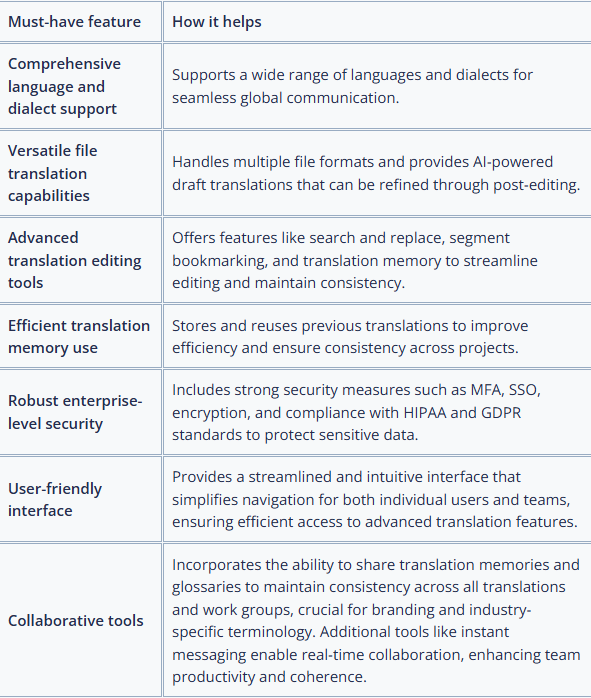Most Accurate Translator Tool: What to Look for
 Liam Corwin
Liam Corwin
Need the most accurate translator for your organization’s language translation projects? If the answer is yes, it’s important to understand that accurate translator tools don’t exist without some form of human input (even the ones that claim to be “accurate translation software” online).
This is because most are built on machine translation, which, while advanced, is an innately imperfect technology. Moreover, it’s important to note that human translation is not flawless either.
However, if your organization is willing to put some resources toward training an AI translation tool, you can actually produce reusable high-quality translations for your organization’s specific terminology and concepts.
In effect, you’ll have the most accurate translator online that’s tailored to your products, services, and brand guidelines, which is even better.
Overview
In today’s globalized world, high-quality translation is essential for organizations operating across multiple languages. Whether it’s legal documents, marketing materials, or technical manuals, the demand for precision in translation is higher than ever.
This article will guide you through the key factors to consider when choosing the most accurate translator, including:
Important factors in choosing the most accurate translator
The “must-have features” of an accurate translator
The role of AI in improving your translations
Key steps to generate accurate translations
And finally, at the end, you’ll receive a recommendation for the most high-quality translator.
Key Factors in Choosing the Most Accurate Translator
Accuracy in translation hinges on several factors. Each factor is critical to ensuring that the original meaning of the text is preserved across various languages, especially for global organizations. So, what are the key factors? They include:
Continuous Learning & Improvement: AI-powered translation such as dynamic machine learning adapts to user input over time. This continuous learning process enhances the accuracy of translations, particularly for specialized content.
Contextual Understanding: Accurate translation requires understanding the context in which words and phrases are used. This includes idiomatic expressions, slang, and cultural references that may not have direct translations.
Handling of Industry-Specific Terminology: Specialized industries like legal, medical, and technical fields have specific jargon that requires precise translation to maintain accuracy and avoid misinterpretation.
Consistent Terminology Usage: For businesses, maintaining consistency in terminology is crucial. This is especially true for brand names, product descriptions, and industry-specific terms.
By understanding these factors, you can better assess which translation tools or services will meet your needs. So what are the features you should look for?
7 Must-Have Features of a High-Accuracy Translation Tool
When choosing the most accurate translator for your organization, it’s essential to focus on key features that enhance translation quality. Additionally, prioritize tools that streamline workflows and ensure data security.
Look for translator tools equipped with the following seven must-have features:

The capabilities of translation software are continuously being enhanced. Discover more top features to consider in the most advanced translation tools, especially those with OpenAI integrations.
So, let’s talk about AI. What is the role of AI in improving translation accuracy?
AI has revolutionized the translation industry by significantly improving accuracy and efficiency. What does it mean for translators?
It’s no longer the elephant in the room.
In the previous section, we highlighted features designed to support your translators in their work.
Why is this important? In 2023, ATA released a statement on artificial intelligence, recognizing AI as a valuable tool for translators. In fact, they’re ahead of the game on translation tools that use AI. They also emphasized that AI can be effectively integrated into a translators’ toolkit to enhance productivity.
It’s not a replacement for human translators.
Rather than replacing human translators, AI should serve as a powerful supplement to their capabilities, and we should openly acknowledge that. While AI can significantly speed up the translation process and improve accuracy, the subtlety and cultural nuance that human translators bring to the table are irreplaceable.
That’s why it’s important to see AI-powered translation tools as opportunities to streamline your workflows, reduce repetitive tasks, and ultimately produce more accurate and higher quality translations.
Conclusion
While no translation tool — human or machine — is flawless, the most accurate translations are achieved through a blend of AI technology and human input. By investing in AI-powered platforms and integrating translation memories, glossaries, and human review, your organization can create tailored, reusable translations that improve over time. This approach not only enhances translation quality and consistency but also delivers measurable efficiency and cost savings. In the end, the most accurate translator is one that continuously learns from your content and evolves with your organization’s needs.
Subscribe to my newsletter
Read articles from Liam Corwin directly inside your inbox. Subscribe to the newsletter, and don't miss out.
Written by

Liam Corwin
Liam Corwin
With over 10 years of experience in translation management and localization strategy, I’ve helped global teams streamline multilingual content delivery. Passionate about scalable solutions that bring speed, security, and precision to complex workflows.